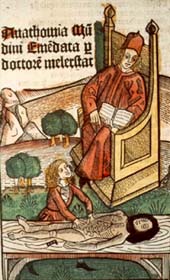Mondino de Liuzzi
| Mondino de Luzzi | |
|---|---|

Mondino de Luzzi, "Lesson in Anatomy", originally published in Anatomia corporis humani, 1493. Courtesy of the National Library of Medicine
|
|
| Born | ca. 1270 AD |
| Died | 1326 AD |
| Occupation | Anatomist, physician, professor |
Mondino de Luzzi, or de Liuzzi or de Lucci, (ca. 1270 – 1326), also known as Mundinus, was an Italian physician, anatomist and professor of surgery, who lived and worked in Bologna. He is often credited as the restorer of anatomy because he made seminal contributions to the field by reintroducing the practice of public dissection of human cadavers and writing the first modern anatomical text.
He was born around 1270 into the prominent Florentine de Luzzi family with loyalties to the Ghibellines and inscribed to the Società dei Toschi, a medieval institution of Bologna for people from Tuscany. His father, Nerino, and grandfather Albizzio were both pharmacists in Bologna, and his uncle Luzio (also Liuzzo or Lucio) was a professor of Medicine. Mondino studied at the University of Bologna in the College of Medicine and the College of Philosophy, graduated around 1290, and he was employed as a public lecturer in practical medicine and surgery at the university from 1306 to 1324. During his schooling, Mondino was a pupil of Thaddeus of Florence (Taddeo Alderotti), who made significant contributions to the development of medicine at Bologna, and a fellow student of Henri de Monteville. In addition to his achievements as an anatomist, Mondino was highly regarded as a diplomat. He was involved in city government and served as an Ambassador of Bologna to John, the son of King Robert of Naples. Mondino died in Bologna in 1326 and was buried in the parochial church of San Vitale e Agricola along with his uncle Leuzzo, who was also a lecturer in medicine. His granite tomb is adorned with a bas-relief, sculpted by Boso of Parma, which depicts an instructor seated in a large chair lecturing to students.
Mondino was the first to incorporate a systematic study of anatomy and dissection into a medical curriculum. The dissection of human cadavers was a hallmark of the Alexandrian school, but declined after 200 A.D. due to legal and religious proscriptions. These bans were eventually lifted, allowing Mondino to perform his first public dissection in Bologna in January 1315 in the presence of medical students and other spectators. The proceedings were formally sanctioned by the Vatican, and the subject was mostly likely a female executed criminal. It was common practice for the professor of anatomy to sit in a large, ornate chair elevated above the dissection proceedings, reading from an anatomical text and providing commentary, while a demonstrator, or surgeon, physically performed the dissection. Additionally, an ostensor was present to point out the specific parts of the body that were being examined. Mondino's teaching methods were unique because he often performed dissections in person and served the role of demonstrator himself, carefully studying the cadaver and incorporating this personal experience into his text and teaching.
...
Wikipedia
